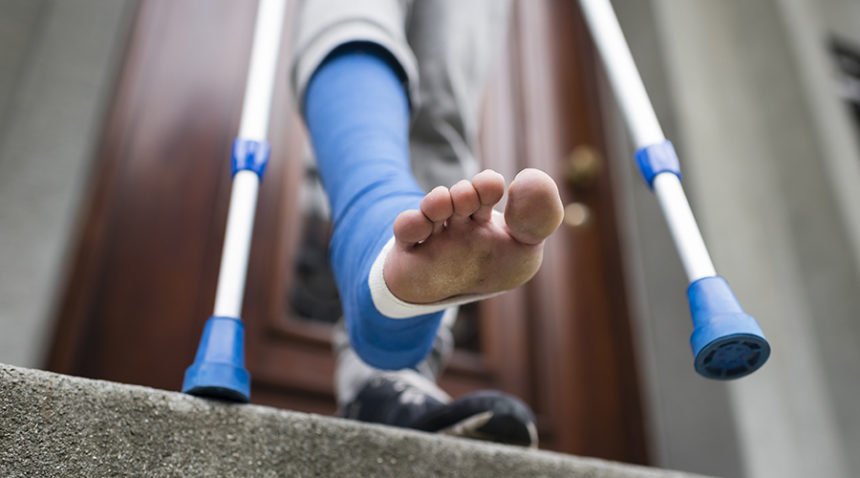Home should be a safe place, but millions of people are seriously injured at home each year. During the COVID-19 pandemic with people spending more time than ever at home, emergency departments have seen more of certain types of injuries than usual.
Carolina Mendoza, MD, assistant medical director at the UNC Hospitals Emergency Department, shares the seven injuries she and her colleagues have seen more frequently in the past year.
1. Falls
“One of the most common home incidents resulting in injuries that send people to the emergency department are falls,” Dr. Mendoza says. “And during the pandemic, we have seen more injuries from accidental falls.”
Older adults are most vulnerable to injury from falls, which are the leading cause of injury-related death among people 65 and older. And during the pandemic, they haven’t been getting as much help from family or paid caregivers.
But falls can happen to anyone of any age, and the cause can be remarkably mundane: getting tangled in sheets when getting out of bed, missing a step on the stairs, slipping in the bathroom or trying to walk without a cane or walker.
“Falls commonly cause cuts, scrapes, bumps to the head and concussions, fractures, dislocations, and hand and wrist injuries,” Dr. Mendoza says. “In those who are on blood thinners, we see subdural hematomas, which is bleeding in or around the brain.”
To prevent falls, eliminate obstacles in the home that pose a tripping hazard, install grab rails or supports in places such as the bathroom, and use your cane or walker if you have one. Ask your doctor if any of your medications cause dizziness. If you drink alcohol, do so only in moderation.
2. Cuts
Cuts sounds like a relatively minor injury, but they can be dangerous when there’s heavy bleeding or an infection. People often cut themselves at home while preparing food in the kitchen and working on home improvement projects, says Dr. Mendoza, who has seen an increase in cuts on the hands and fingers.
“It may be counterintuitive, but make sure you are using a sharp knife when cutting and prepping food,” Dr. Mendoza says. “A dull knife will make it more difficult to slice through food and can slip, causing you to cut yourself.”
Using a cutting board can reduce the risk of knife slips, too—never cut something in your hand. If you’re doing home repairs, wear sturdy work gloves and don’t tackle projects that feel beyond your skill set.
3. Burns
Another indication more people have been in the kitchen: more burns from boiling water or hot oil.
“We’ve also seen burns from exposure to chemicals and accidents when starting or tending to a fire,” Dr. Mendoza says.
When cooking, pay attention to what you’re doing, wear protective gear as needed (such as oven mitts) and keep children and pets away. If using potentially hazardous chemicals, such as bleach, drain cleaner or paint thinner, read all the instructions, wear protective gear and store them out of reach of children. Make sure there’s a working smoke detector on every level of your home, and never leave any type of fire, including campfires and fire pits, unattended or in reach of children or pets.
4. Poisonings
Poisonings are the most common preventable injury cause of death in the home.
Accidental overdoses can happen if you forget whether you have taken a dose of medication and then take it again. Poisonings also can happen if children are able to reach medications, household cleaners or chemicals. In the winter, carbon monoxide poisoning can result from keeping gas grills or heaters inside, or because a gas furnace malfunctions.
“Make sure your smoke alarms are working properly and have good batteries,” Dr. Mendoza says. “Add a carbon monoxide alarm to your home if you don’t have one. Keep medications and household cleaners in places that children cannot reach, and help older loved ones keep track of when they are supposed to take their medications.”
5. Gunshot Wounds
Dr. Mendoza says the emergency department is seeing more injuries from accidents involving guns at home, especially bullet wounds in the legs, feet and toes.
“We’ve seen incidents in which children have found loaded guns in the house and fired the weapon,” Dr. Mendoza says. “We’ve also seen incidents with adults who didn’t know the gun was loaded or the safety was off or had an accident while cleaning their gun.”
If you have a gun in your home, keep it locked in a place where children cannot access it, and store firearms and ammunition separately, both under lock. Make sure anyone who handles the firearm understands how to do so safely.
6. Injuries from Domestic Abuse
Stay-at-home orders have helped protect people from COVID-19, but they also have led to a tragic increase in domestic violence.
“Unfortunately, we’ve seen a significant increase in injuries from physical abuse,” Dr. Mendoza says. “Kids and women have been stuck inside their homes with their abuser, which has resulted in more instances of domestic abuse.”
If you or a loved one is a victim of domestic abuse, visit the National Domestic Violence Hotline website or call (800) 799-7233. If you’re not safe making a phone call, the site has a chat function.
7. Self-Harm Injuries
The mental health toll of the pandemic has been substantial, especially for people with anxiety and depression. Dr. Mendoza says visits to the emergency department for mental health issues have increased and involve injuries that result from self-harm or attempts at suicide, including intentional drug overdoses.
Here are ways to find help with your mental health during the pandemic and a list of resources for preventing self-harm and suicide. The 988 Suicide & Crisis Lifeline is staffed 24 hours a day, seven days a week. Call or text 988.
For more safety tips and prevention education, visit the UNC Tar Heel Trauma Program.

